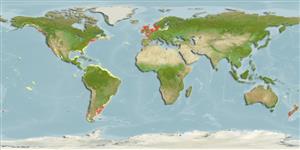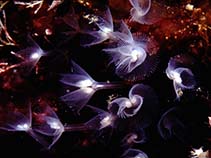Phoronis hippocrepia Wright, 1856
| Native range | All suitable habitat | Point map | Year 2050 |

|
| This map was computer-generated and has not yet been reviewed. |
| Phoronis hippocrepia AquaMaps Data sources: GBIF OBIS |
Classification / Names Common names | Synonyms | CoL | ITIS | WoRMS
Not assigned | Not assigned | Phoronidae
Environment: milieu / climate zone / depth range / distribution range Ecology
Benthic; depth range 0 - 55 m (Ref. 83939). Subtropical
Distribution Countries | FAO areas | Ecosystems | Occurrences | Introductions
Atlantic Ocean, Pacific Ocean and the Mediterranean.
Length at first maturity / Size / Weight / Age
Maturity: Lm ? range ? - ? cm Max length : 10.0 cm TL male/unsexed; (Ref. 402)
This is a benthic species found on rocky bottoms particularly in intertidal and subtidal areas (Ref. 83938). It is a burrowing and encrusting species inhabiting hard substrates like rocks, empty mollusk shells, Caryophyllia and Lithothamnion (Ref. 402).
Life cycle and mating behavior Maturity | Reproduction | Spawning | Eggs | Fecundity | Larvae
Members of the phylum Phoronida are mostly hermaphroditic. Life cycle: Embryos develop into free-swimming planktotrophic actinotrocha larvae which later sinks to the bottom and metamorphose into benthic adults.
Main reference
References | Coordinator | Collaborators
Hansson, H.G. 1999. (Ref. 997)
IUCN Red List Status (Ref. 130435)
CITES status (Ref. 108899)
Not Evaluated
CMS (Ref. 116361)
Not Evaluated
Threat to humans
Human uses
| FishSource |
Tools
More information
Age/Size
Growth
Length-weight
Length-length
Morphology
Larvae
Abundance
Growth
Length-weight
Length-length
Morphology
Larvae
Abundance
Internet sources
Alien/Invasive Species database | BHL | BOLD Systems | CISTI | DiscoverLife | FAO(Publication : search) | Fishipedia | GenBank (genome, nucleotide) | GloBI | Gomexsi | Google Books | Google Scholar | Google | PubMed | Tree of Life | Wikipedia (Go, Search) | Zoological Record
Estimates based on models
Preferred temperature
(Ref. 115969): 8.6 - 15.8, mean 10.7 (based on 560 cells).
Price category
(Ref. 80766):
Unknown.



